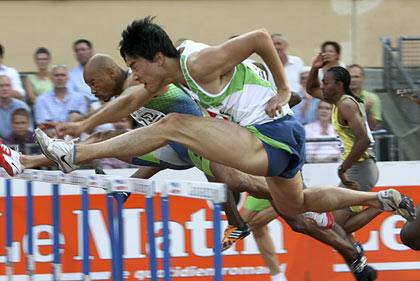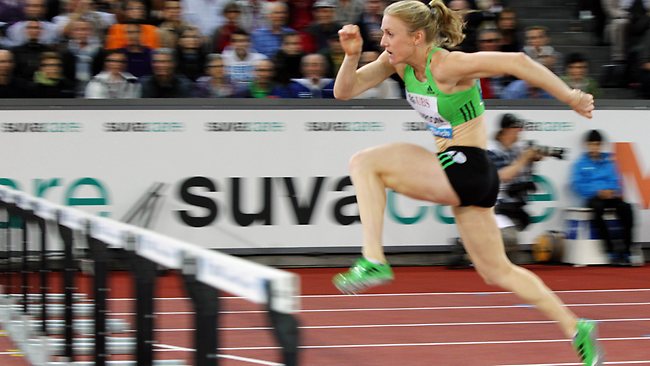Speed Rhythm & Technique
by Steve McGill
Which part of the breath is more important, the inhale or the exhale? What is most essential to survival – food, water, or shelter? Which part of a bowling ball toss is most important – the approach, the release, or the follow-through? Which is more important in conceiving a baby – the sperm or the egg? These are all obviously dumb questions. Yet when it comes to hurdles, we way too often tend to over-emphasize – and consequently under-emphasize – certain components of a race.
[am4show not_have=’g5;’]
[/am4show][am4guest]
[/am4guest][am4show have=’g5;’]
When coaching hurdlers at all levels, I teach that there are three primary components to running the hurdles: speed, rhythm, and technique. In my early years of coaching, I was definitely guilty of over-emphasizing technique. Throughout my own hurdling years in high school and especially in college, I had grown fascinated with hurdling technique – with the nuances, with the possibilities, with how one subtle adjustment could cause a ripple effect of improvements. I also quickly discovered that the superior technique of my hurdlers allowed them to defeat hurdlers from other teams who were faster and stronger. So I developed the attitude that speed didn’t really matter if you had the technique.
Meanwhile, as indicated above, I noticed that most coaches over-emphasized speed. This is still the case to this day, by the way. If anything gets over-emphasized way too much, it’s speed. Instead of addressing technical flaws, many hurdlers try to power their way through them. As a result, the speed itself ends up being compromised, because you can’t run fast between the hurdles if you’re all over the place over the hurdles.
Then there are the rhythm people. One of my former coaching partners was a big rhythm guy. The hurdles are a dance, he said, and hurdlers are dancers. So when he had his hurdlers doing a lot of reps of hurdle drills, he didn’t place a big emphasis on addressing technical flaws like I did. His whole thing was to have the athletes “dial in” to the rhythm. And to a very large degree, it worked. His hurdlers had a unique, uncanny ability to adapt their speed to the rhythm of any spacing in any drill. If one hurdle in a drill had been accidentally spaced too close or too far away, they could adapt on the fly by shortening or lengthening their stride. In races, even with glaring technical flaws in some cases, they were able keep their rhythm, keep dancing.
So, hurdlers who emphasize technique have success, hurdlers who emphasize speed have success, and hurdlers who emphasize rhythm have success. But for all of them, the success is limited by their deficiencies in one or both of the other two areas. To truly reach one’s potential, to truly master the event, one has to be proficient in all three areas – speed, rhythm, and technique.

When it comes to combining speed, rhythm, and technique, no one has ever done it better than Liu Xiang.
My moment of epiphany that allowed me to realize that technique isn’t the end-all and be-all of hurdling occurred about ten years ago, when I was coaching a girl who was a pretty good sprinter and wanted to learn how to hurdle. She definitely had the speed to three-step, but like most beginners, she was afraid to really attack the barriers. So I loaded her up on drills in the off-season, teaching her lead leg mechanics, trail leg mechanics, lead arm, trail arm, lean, everything. After about three weeks of nothing but drilling to refine technique, I set up the first hurdle on the race mark and instructed her to attack it full speed from the start line.
I assumed, of course, now that we had done so much hurdling at slower speeds and tighter spacings, she would feel confident enough to go for it. But no. Every time, she ran up to the hurdle, then slammed on the brakes and put her hands on the crossbar. I lowered the hurdle. I took the top off and rested it against the bottom. Nothing worked. She kept stopping. Eventually, I gave up on the experiment. She never ran a hurdle race. She stayed with the sprints.
Since then, my approach to teaching beginners (and all hurdlers, for that matter) has changed. Even on day one with a new hurdler, I will have him or her clear the first hurdle at full speed. I don’t care about your technique, I’ll tell the athlete, just get over it any way any how. In most sessions that are drill-heavy, in which we work primarily on rhythm and technique, I’ll end the session with a handful of reps over one or two hurdles full speed from the line, usually with a three-point start. These reps at the end of the workout reveal to me and to the athlete which aspects of technical development have become ingrained vs. those that we need to continue to work on.

In the women’s race, Sally Pearson has set the gold standard for putting speed, rhythm, technique into her race at a high level of efficiency.
This past weekend I was coaching a girl from out of town who, as a high school freshman last year, dropped her time from the mid-19’s at the beginning of her spring season to the mid-16’s by the end. This was my second time working with her. In our previous sessions last month, we broke down and rebuilt her technique, as she had a multiplicity of flaws to address. This time, we worked more on speed. In her races last spring, she had run that 16-mid race 9-stepping to hurdle one and 4-stepping the rest of the way.
We spent two entire sessions working almost solely on her start to the first hurdle. Switching from a 9-step approach to an 8-step approach proved very difficult for her – not because she wasn’t fast enough to 8-step, nor because she struggled with switching her feet at the start, but because she had grown so accustomed to the rhythm of 9-stepping. At first, she wouldn’t push off the pedals; she would just step out of the blocks. Then, once we resolved that problem, she would quicken up and shorten up her middle strides – strides 4-6. Then, finally, she started driving all the way through the hurdle for all eight steps.
Then, with that kind of speed going into hurdle one, 3-stepping hurdle two became easy. She was already in the rhythm that she needed to be in; she was already running as fast as she needed to run. And all the drilling we had done had improved her technique. So she was finally putting all three components together. I’m convinced that this girl can run 15-low next year if she continues to develop all three components together.
Hurdlers should always be looking to improve their flat speed. Speed comes first in any foot-race, speed makes everything else easier. But because there are obstacles in the way in a hurdle race, hurdlers need to do rhythm-based drills so that they are constantly incorporating their speed into the race rhythm. Otherwise, speed can cause more problems than it solves. And technique must constantly be developed so that the benefits of speed and rhythm can be maximized.
[/am4show]
